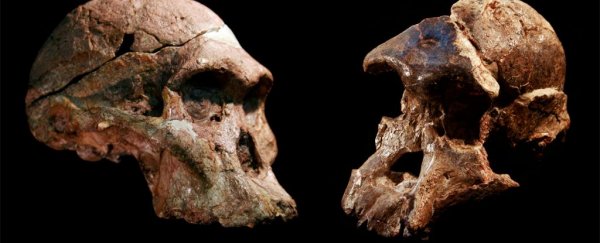Multiple ancient hominin remains from caves in South Africa may be much, much older than previous estimates suggested.
The Sterkfontein limestone cave system, not far from Johannesburg, has yielded so many ancient bones from the hominin genus Australopithecus over the last century that its location has been dubbed the Cradle of Humankind – deeply important to the study of human evolution.
Now, new dating techniques suggest that the remains date back nearly 4 million years – making them even older than the famous Australopithecus afarensis individual Dinkinesh, nicknamed Lucy.
"Sterkfontein has more Australopithecus fossils than anywhere else in the world," said geologist and geophysicist Darryl Granger of Purdue University.
"But it's hard to get a good date on them. People have looked at the animal fossils found near them and compared the ages of cave features like flowstones and gotten a range of different dates. What our data does is resolve these controversies. It shows that these fossils are old – much older than we originally thought."
Dating ancient remains isn't exactly easy, especially in caves. Dinkinesh was dated to 3.2 million years ago, based on radiometric dating of the volcanic ash in the sediment where she was found, but caves are a more pristine environment, where volcanic ash doesn't fall.
Previous estimates for the complex Sterkfontein system were based on the age of calcite flowstone found within the cave fill. It formed around 2 to 2.5 million years ago.
However, flowstone can form over older sediment, and this seems to have been the case in Sterkfontein.
Most of the Sterkfontein Australopithecus remains have been recovered from a cave infill called Member 4. That's exactly what it sounds like: material that filled what was previously a cavity, resulting in a sedimentary deposit; in this case, concealing but preserving ancient hominin remains. Member 4 previously yielded the famous Mrs. Ples skull, the most complete example of its kind ever discovered.
Previous work on another famous Sterkfontein Australopithecus skeleton, that of the individual named Little Foot, excavated from the infill Member 2, returned an age of 3.67 million years. Granger's methods were instrumental in that dating. Since the ages of other deposits are still the topic of hot debate, he and colleagues turned their methods to Member 4.
Rather than examining the flowstone, or other bones found nearby (that may not be contemporaneous to the remains in question), the team examined the rock in which the Australopithecus remains were embedded. Specifically, they probed the radioactive decay of two rare isotopes in quartz: aluminum-26 and beryllium-10.
"These radioactive isotopes, known as cosmogenic nuclides, are produced by high-energy cosmic ray reactions near the ground surface, and their radioactive decay dates when the rocks were buried in the cave when they fell in the entrance together with the fossils," Granger explained.
From these isotopes, the team discerned that the Australopithecus-bearing sediments all date from between 3.4 and 3.7 million years ago. That means the remains recovered from the deposit are all from around the beginning of the Australopithecus era, and not its end as previously thought.
This has important implications for our understanding of human evolution, and Sterkfontein's place in it, the researchers said.
"Younger hominins, including Paranthropus and our genus Homo, appear between about 2.8 and 2 million years ago," said archaeologist Dominic Stratford of the University of the Witwatersrand in South Africa, Sterkfontein research coordinator.
"Based on previously suggested dates, the South African Australopithecus species were too young to be their ancestors, so it has been considered more likely that Homo and Paranthropus evolved in East Africa."
The new result, consistent with the dating of Little Foot, suggests that Homo and Paranthropus – also found in the Cradle of Humankind – emerged nearly a million years after the Member 4 individuals lived, which means the order of events, and where they occurred, can be revised.
"The redating of the Australopithecus-bearing infills at the Sterkfontein Caves will undoubtedly re-ignite the debate over the diverse characteristics of Australopithecus at Sterkfontein, and whether there could have been South African ancestors to later hominins," Granger said.
The team's research has been published in PNAS.
